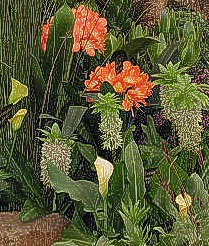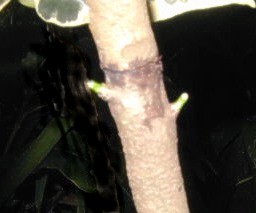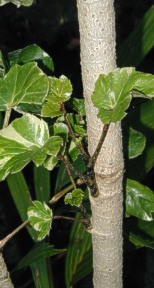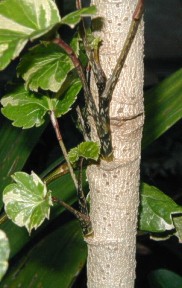From the Ground Up
The Kindest Cut
by Derek Burch
Consider
this single fact from the article in the previous issue: the terminal
bud of a shoot produces a substance (auxin) that travels downwards in
the stem and holds back the growth of lateral buds below the terminal
bud.

If you remove the terminal bud, the lateral buds are released to grow. But cutting off the tip of the shoot wastes energy that the plant has put into growing that shoot. What if you could interfere with the downwards flow of the auxin and prevent it reaching the lateral buds? Ah, but you can! This is one of the easiest manipulations of growth to perform, but one of the processes that we rarely spell out.
Most gardeners have at least heard of the propagation method called air-layering (well I call it air-layering, the higher priced books call it marcottage - but these are written by the same people who call taking a cutting "cuttage," and probably say "seedage" and "divisionage," but as long as they are gardeners and not garden journalists that is OK). Air-layering involves interfering with the transport up and down the stem by taking off a ring of bark, or making an oblique cut through part of the stem. This is best done on a woody shoot growing in good light. Water can still pass freely up the stem to serve the leaves at the top because the tissue that transports it (the xylem, go back a few issues if you don't remember), is left largely intact, but the tissue (the phloem) that carries the sugars made in the leaves, and also the auxin from the terminal bud, downwards has been cut. The damaged part of the stem, incidentally is usually kept moist with sphagnum moss or some hi-tech substitute.
Now, what is the result of this? Well, first of all, the sugars accumulate on the upper side of the cut, making the stem rich in food in that region. The auxin also accumulates, and such is the master plan under which all this operates, the greater auxin concentration stimulates the damaged tissue into producing roots. On the lower side of the cut, the tissue is released from the effect of the auxin, and buds which were inhibited from growth are now able to develop as new shoots.
So here we have the wonderful result of a damaged stem in which the upper part with all its leaves intact is growing roots while still attached to the parent plant, and the lower part is busy producing new shoots. When the stage of development is right, the gardener cuts the shoot below the new roots (that is between the roots and the new shoots) and has a complete small plant - roots, stem and leaves, ready to plant and nurture while it gets over the shock AND a parent plant in which on one or more shoots are present with leaves to replace those cut off with the small plant. And all of this has come about because the flow of auxin down the stem was interrupted by the original wounding.
I should mention that air-layering is not safe to do on the only shoot of a small plant. Preventing the downward flow in the stem means that the roots are not getting the sugars which they need to keep them alive, and the plant will often die before it makes the new shoots that would once again supply the lower parts of the plant.
There is another similar operation
which I use a lot (might this be woundage, perhaps, or notchage or whatever
you would like to call it) in which I fill in a blank area of a plant
stem with shoots by making a small moon-shaped cut above a dormant bud.
You can imagine what happens: the bud is still supplied with water from
below, but the inhibitory effect of the auxin from above is removed, and
the bud has a chance to grow out. You can get nicely placed and separated
shoots on an over-tall unbranched whip of a young tree by doing several
of these notches at strategic spots.
| I use a coarser version in getting some of the tropical shrubs to fill in if they are a little bare. I run a knife or my pruning shears around the stem, or mash the bark with pliers at a point a little below where I want the fullness to develop. |
 |
|
Buds sprout below the damaged
area
|
|
|
Several buds will develop just below this damage in many cases, because the inhibitory effect of the auxin is removed, and I can then cut the top of the branch off leaving the several shoots, or leave the whole thing to grow out, but now with foliage developing part way up the stem as well as at the top. |
| Success! Shoots are developing below the knife cut around the stem |
The cut-off part will often root easily as a cutting because there has been accumulation of food and auxin above the damaged part, which now is the base of the cutting from which you want roots to develop.
These are relatively crude examples of what manipulation of a shoot is possible. Advanced propagators use more refined methods based on the same principles in propagating hard to root trees and shrubs. As I have said before, fascinating things, plants!
Back to the Table of Contents

